Muisca
Muysca | |
|---|---|
 | |
| Total population | |
| 14,051[1](2005, census) | |
| 10,000,000 Chibcha Mestizos (approximately)[2] | |
| Regions with significant populations | |
| Altiplano Cundiboyacense, | |
| Languages | |
| Chibcha,Colombian Spanish | |
| Religion | |
| Muisca religion,Catholicism | |
| Related ethnic groups | |
| Guane,Lache,U'wa,Tegua,Guayupe,Sutagao,Panche,Muzo |


Lake Totais clearly visible


TheMuisca(also calledChibcha) are anindigenous peopleandcultureof theAltiplano Cundiboyacense,Colombia,that formed theMuisca Confederationbefore theSpanish conquest.The people spoke Muysccubun, a language of theChibchan language family,also calledMuyscaandMosca.[3]They were encountered byconquistadorsdispatched by theSpanish Empirein 1537 at the time of theconquest.
Subgroupings of the Muisca were identified chiefly by their allegiances to three great rulers: thehoa,centered inHunza,ruling a territory roughly covering modern southern and northeasternBoyacáand southernSantander;thepsihipqua,centered inMuyquytáand encompassing most of modernCundinamarca,the westernLlanos;and theiraca,religious ruler ofSuamoxand modern northeastern Boyacá and southwestern Santander.
The territory of the Muisca spanned an area of around 25,000 km2(9,700 sq mi) from the north ofBoyacáto theSumapaz Páramoand from the summits to the western portion of theEastern Ranges.Their territory bordered the lands of thePanchein the west, theMuzoin the northwest, theGuanein the north, theLachein the northeast, theAchaguain the east, and theSutagaoin the south.
At the time of the Spaniard invasion, the area had a large population, although the precise number of inhabitants is not known. Estimates vary from 1 million to over 3 million inhabitants. Theireconomywas based onagriculture,saltmining,trading,metalworking,andmanufacturing.
Due to Spanish colonization, the population of the Muisca has drastically decreased and assimilated into the general population. The descendants of the Muisca are often found in rural municipalities includingCota,Chía,Tenjo,Suba,Engativá,Tocancipá,Gachancipá,andUbaté.[4]A census by the Ministry of Interior Affairs in 2005 reports a total of 14,051 Muisca people in Colombia.[1]
Much of the historic knowledge about the Muisca comes from the testimonies ofconquistadorsand colonistsGonzalo Jiménez de Quesada;Spanishpoet,soldier,andpriestJuan de Castellanos(16th century);bishopLucas Fernández de PiedrahitaandFranciscanPedro Simón(17th century).
More recently,Javier Ocampo LópezandGonzalo Correal Urregohave contributed notable scholarship.
History of the Muisca[edit]


Knowledge of events up until 1450 is mainly derived from mythological contexts, but thanks to theChronicles of the West Indieswe do have descriptions of the final period of Muisca history, prior to Spanish arrival.
Background[edit]
Excavations in theAltiplano Cundiboyacense(the highlands ofCundinamarcaandBoyacádepartments) show evidence of human activity since theArchaic stageat the beginning of theHoloceneera. Colombia has one of the most ancient archaeological sites of the Americas:El Abra,which is estimated to be approximately 13,000 years old. Other archaeological traces in the region of the Altiplano Cundiboyacense have led scholars to talk about anEl AbraCulture: InTibitó,tools and other lithic artifacts date to 9740 BCE; on the Bogotá savanna, especially atTequendama Falls,other lithic tools dated a millennium later were found that belonged to specialized hunters. Human skeletons were found that date to 5000 BCE. Analysis demonstrated that the people were members of the El Abra Culture.
Muisca era[edit]
Scholars agree that the group identified as Muisca migrated to the Altiplano Cundiboyacense in theFormative era(between 1000 BCE and 500 CE), as shown by evidence found atAguazuqueandSoacha.Like the other formative-era cultures of America, the Muiscas were transitioning between being hunter-gatherers and becoming sedentary farmers. Around 1500 BCE, groups of agrarians with ceramic traditions came to the region from the lowlands. They had permanent housing and stationary camps, and worked the salty water to extract salt. InZipacónthere is evidence of agriculture and ceramics. The oldest settlement of the highlands dates to 1270 BCE. Between 800 BCE and 500 BCE, a second wave of migrants came to the highlands. Their presence is identified by multicolor ceramics, housing, and farms. These groups were still in residence upon the arrival of the Spanish invaders. They left abundant traces of their occupation that have been studied since the 16th century, and allow scientists to reconstruct their way of life. It is possible that the Muisca integrated with more ancient inhabitants, but the Muisca were the ones who molded the cultural profile and the social and political organization. Their language, a dialect ofChibcha,was very similar to those peoples of theSierra Nevada de Santa Marta(Kogui,Ijka, Wiwa, andKankuamo) and theSierra Nevada del Cocuy(U'wa).
Wars[edit]
ZipaSaguamanchica(ruled 1470 to 1490) was in a constant war against aggressive tribes such as theSutagao,and especially thePanche,who would also make difficulties for his successors,NemequeneandTisquesusa.TheCaribswere also a permanent threat as rivals of thezaqueofHunza,especially for the possession of the salt mines ofZipaquirá,NemocónandTausa.
Timeline of inhabitation of the Muisca area[edit]
| Timeline of inhabitation of the Altiplano Cundiboyacense, Colombia | |
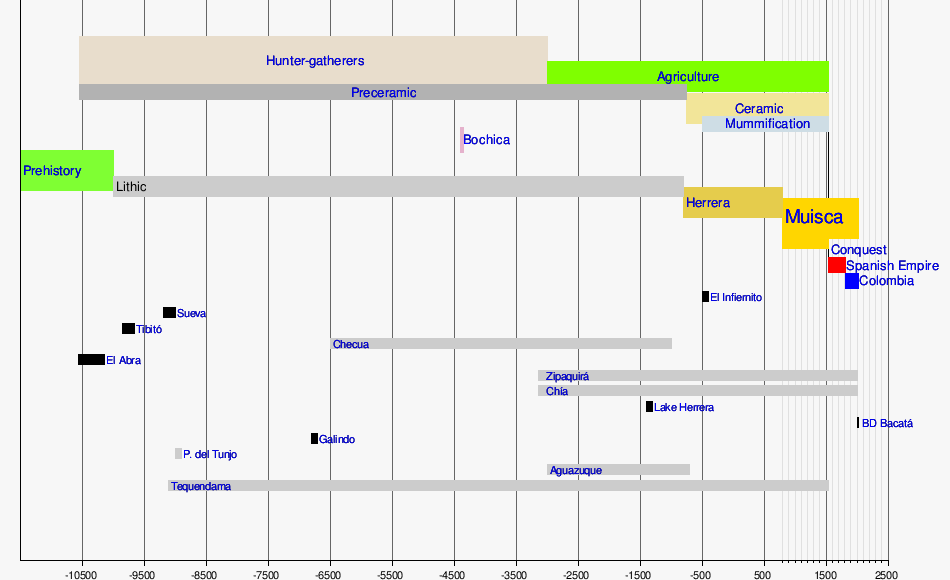 |
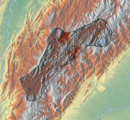 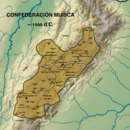 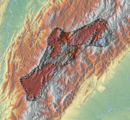 |
Political and administrative organization[edit]

Showing theZipa,Zaque,andIndependent territories
The Muisca people were organized in aconfederationthat was a loose union of states that each retained sovereignty. The confederation was not a kingdom, as there was no absolute monarch, nor was it anempire,because it did not dominate other ethnic groups or peoples. It is hard to compare the Muisca Confederation with other American civilizations, such as theAztecor theIncaempires as it was more similar to a confederation of states, such as theAchaean League.The Muisca Confederation was one of the biggest and best-organized confederations of tribes on the South American continent.[5]
Every tribe within the confederation was ruled by a chief or acacique.Most of the tribes were part of the Muisca ethnic group, sharing the same language and culture and forming relations through trade. They united in the face of a common enemy. The army was the responsibility of thezipaorzaque.The army was made up of thegüeches,the traditional ancient warriors of the Muisca.
The Muisca Confederation existed as the union of two lesser confederations. The southern confederation, headed by thezipa,had its capital at Bacatá (nowBogotá). This southern polity included the majority of the Muisca population and held greater economic power.
The northern territory was ruled by thezaque,and had its capital in Hunza, known today asTunja.Although both areas had common political relations and affinities and belonged to the same tribal nation, there were still rivalries between them. Among the territories there were four chiefdoms:Bacatá,Hunza,Duitama,andSogamoso.The chiefdom was composed by localities.[6]The tribes were divided intoCapitanías(ruled by a capitan). There were two kinds:Great Capitania(sybyn) andMinor Capitania(uta). The status ofCapitanwas inherited by maternal lineage.[6]
- Confederation (zipaorzaque)
- →Priests (Iraca)
- →Chiefdoms (Cacique)
- →Capitanía(Capitan)
- →Sybyn
- →Uta
- →Sybyn
- →Capitanía(Capitan)
- →Chiefdoms (Cacique)
- →Priests (Iraca)
- Territories of thezipa:
- Bacatá rule:Teusaquillo,Tenjo,Subachoque,Facatativá,Tabio,Cota,Chía,Engativá,Usme,Zipaquirá,NemocónandZipacón
- Fusagasugá District:Fusagasugá,PascaandTibacuy
- Ubaté District:Ubaté,Cucunubá,Simijaca,Susa
- Guatavita District:Gachetá,GuatavitaandSuesca,Chocontá,Teusacá,Sesquilé,Guasca,Sopó,Usaquén,Tuna,Suba
- Territories of thezaque:
- Territory ofTundama:Cerinza,Oicatá,Onzaga,Sativanorte,Sativasur,Soatá,Paipa,Tobasia
- Territory ofSugamuxi:Busbanzá,Toca,Pesca,Pisba,Tópaga
- Autonomous chiefdoms:Charalá,Chipatá,Tinjacá,Saboyá,Tacasquirá
The Muisca legislation wasconsuetudinary,that is to say, their rule of law was determined by long-extant customs with the approval of thezipaorzaque.This kind of legislation was suitable to a confederation system, and it was a well-organized one. The natural resources could not be privatized: woods, lakes, plateaus, rivers and other natural resources were common goods.
Language[edit]

Chibcha,also known asmuysca,mosca,ormuysca cubun,belongs to theChibchan languages.It was spoken across several regions ofCentral Americaand the north ofSouth America.TheTaironaculture and theU'wa,related to the Muisca culture, speak similar languages, which encouraged trade. The Muisca used a form ofhieroglyphsfor numbers.
Many Chibcha words were absorbed or "loaned" into Colombian Spanish:
- Geography: Many names of localities and regions were kept. In some cases, the Spanish named cities with a combination of Chibcha and Spanish words, such asSanta Fe de Bogotá(Chibcha: "Bacatá" ). Most of the municipalities of theBoyacáandCundinamarcadepartments are derived from Chibcha names:Chocontá,Sogamoso,Zipaquirá,and many others.
- Fruits, such ascurubaanduchuva.
- Relations: the youngest child is calledcuba,orchinafor a girl;[citation needed]muyscameans people.
Economy[edit]


The Muisca had an economy and society considered to have been one of the most powerful of the AmericanPost-Classic stage,mainly because of the precious resources of the area: gold and emeralds. When the Spaniards arrived in Muisca territory they found a rich state, with the Muisca Confederation controlling mining of the following products:
- emeralds:Colombiais the primary producer of emeralds in the world
- copper
- coal:the coal mines still operate today atZipaquiráand other sites. Colombia has some of the world's most significant coal reserves.[8]
- salt:there were mines in production atNemocón,Zipaquirá,andTausa
- gold:gold was imported from other regions, but it was so abundant that it became a preferred material for Muisca handicrafts. The many handicraft works in gold and thezipatradition of offering gold to the goddessGuatavitacontributed to the legend ofEl Dorado.
The Muisca traded their goods at local and regional markets with a system ofbarter.Items traded ranged from those of basic necessity through to luxury goods. The abundance of salt, emeralds, and coal brought these commodities tode factocurrencystatus.
Having developed an agrarian society, the people used terrace farming and irrigation in the highlands. Main products werefruits,coca,quinoa,yucaandpotatoes.
Another major economic activity was weaving. The people made a wide variety of complex textiles. The scholar Paul Bahn said: "the Andean cultures mastered almost every method of textile weaving or decoration now known, and their products were often finer than those of today."[9]



Carved in stone by Bogotan sculptor María Teresa Zerda
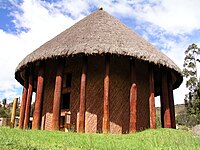
Archaeology Museum, Sogamoso

Gold Museum, Bogotá
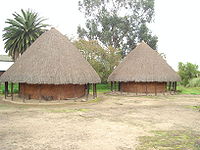
Archaeology Museum of Sogamoso
Culture[edit]
The Muisca were an agrarian and ceramic society of theAndesof the north ofSouth America.Their political and administrative organization enabled them to form a compact cultural unity with great discipline. In Spanish, it is called cultura muisca
The contributions of the Muisca culture to the Colombian national identity have been many.
Heraldry[edit]
Pre-Columbian Muisca patterns appear in various seals of modern municipalities located on theAltiplano Cundiboyacense,for instanceSopóandGuatavita,Cundinamarca.[10][11]The remaining Muisca people in central Colombia also have their own seal.[12]
Sports[edit]
The Muisca culture had certain sports which were part of their rituals. Theturmequégame, also known astejo,has survived and became a popular sport of Colombia. Also important were matches ofwrestling.The winner received a finely woven cotton blanket from the chief and was qualified as aguecha warrior.
Religion[edit]
Muisca priests were educated from childhood and led the main religious ceremonies. Only the priests could enter the temples. Besides the religious activities, the priests had much influence in the lives of the people, giving counsel in matters of farming or war. The religion originally includedhuman sacrifice,but the practice may have been extinct by the time of the Spanish conquest, as there are no first-hand Spanish accounts.
Oral tradition suggests that every family gave up a child forsacrifice,that the children were regarded as sacred and cared for until the age of 15, when their lives were then offered to the Sun-god,Sué.
Deities[edit]
- Sué,Suá, Zuhé or Xué (The Sun god): he is the father of the Muisca. Histemplewas inSuamox,the sacred city of the Sun. He was the most venerated god, especially by the Confederation of thezaque,who was considered his descendant.
- Chía(The Moon-goddess): her temple was in what is today the municipality ofChía.She was widely worshipped by the Confederation of thezipa,who was considered her son.
- Bochica:though not properly a god, he enjoyed the same status as one. He was a chief or hero eternized in the oral tradition. The land was flooded by agoddess,a beautiful and sometimes mean woman, or byChibchacum,protector of the farmers. Bochica listened to the complaints of the Muisca about floods. With his stick, he broke two rocks at the edge of theTequendama Fallsand all the water came out, forming a waterfall. Bochica punished Huitaca and Chibchacum: He made Huitaca an owl and made her hold up the sky. Chibchacum was tasked with holding up the Earth.
- Bachué:the mother of the Muisca people. It was said that a beautiful woman with a baby came out ofLake Iguaque.Bachué sat down at the bank of the lake and waited for the child to grow up. When he was old enough, they married and had many children, who were the Muisca. Bachué taught them to hunt, to farm, to respect the laws, and to worship the gods. Bachué was so good and loved that the Muisca referred to her asFurachoque(Good woman inChibcha). When they became old, Bachué and her husband decided to go back to the deep of the lagoon. That day the Muisca were so sad, but at the same time very happy because they knew their mother was very happy. Other versions of the legend say that after stepping into the lagoon of Iguaque, Bachué ascended to the sky and becameChía;in other versions Chia and Bachué are two different figures.
Astronomy[edit]
The cult of the Muisca centered on two main deities;Suéfor the Sun andChíafor the Moon. They developed a vigesimal (based on 20)calendarand knew exactly the timing of thesummer solstice(June 21), which they considered the Day ofSué,the Sun god. The Sué temple was inSogamoso,the sacred city of the Sun and the seat of theIraca(priest). The Muisca name of the city,SuamoxorSugamuxi,means "City of the Sun". On thesolstice,thezaquewent to Suamox for a major festival where ritual offerings were made. It was the only day of the year when thezaqueshowed his face, as he was considered a descendant of the Sun god.[13]
Mythology[edit]
The Muisca mythology is well documented. Many of the writers who contributed to theChronicles of the West Indieswere based in Bogotá. They recorded many of the myths as they were interested in the traditions and culture of the conquered people. The Muisca territory became the seat of the colonial administration for theNew Kingdom of Granada(Spanish:Nuevo Reino de Granada).
El Dorado[edit]
The origin of the legend ofEl Dorado(Spanish for "The Golden One" ) in the early 16th century may be located in theMuisca Confederation[citation needed].Thezipaoffered gold and other treasures to the Guatavita goddess. To do so, thezipacovered himself with gold dust and washed it off in the lake while tossing gold trinkets into the waters. This tradition was well known outside the Confederation, as far as theCaribbean Sea;the Spaniards were attracted by stories of a "city of gold" that did not exist. Indigenous people sometimes got rid of the avaricious Spaniards in that way, pointing them in the direction of other peoples.Lake Guatavitawas explored by conquistadors who were looking for gold offerings from thezipato the goddess. The legend grew until the term became a metaphor for any place where great wealth may be found or made.
Architecture[edit]
The Muisca did not construct large stone structures. They didn't use the abundant rock to leave monumental ruins as has happened with other American cultures. Their houses were built with materials such as clay, canes, and wood. The houses had a conical form, most of them to the point thatGonzalo Jiménez de Quesada,founder ofBogotá,gave the area the nameValle de los Alcázares( "Valley of the Palaces" ). The houses had small doors and windows, and the dwellings of the higher rank citizens were different. The Muisca used little furniture as they would typically sit on the floor.
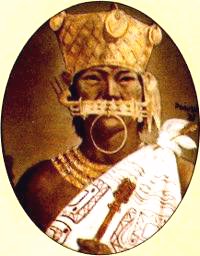
Thezipawas richly ornamented in gold and expensive cloth

The Spanish conquest[edit]
Rivalries between thezaqueand thezipawere taken advantage of by the Spaniards as they conquered the heart of what would be Colombia. Some of them, such asSebastián de Belalcázar,Gonzalo Jiménez de Quesada,andNicolás de Federman,interested in locatingEl Dorado,discovered the rich plains ofCundinamarcaandBoyacá.The presence of the Spaniards gave hope to both sovereigns that, were they to make one Confederation, they could prevail in a war against the Spaniards. But the Spaniards prevailed.
The reaction of the chief leaders and the people did little to change the destiny of the Confederations. The Spanish executed the last Muisca sovereigns,SagipaandAquiminzaque,in 1539 and 1540 respectively. In 1542Gonzalo Suárez Rendónfinally put down the last resistance and the territories of the Confederations were shared by Belalcazar, Federmann, and De Quesada. Later the Spanish Crown would elect De Quesada as the man in charge, with the titleadelantado de los cabildos de Santa Fe y Tunja.
Last Muisca sovereigns[edit]
- ZipasofBacatá:
- Meicuchuca(1450–1470)
- Saguamanchica(1470–1490)
- Nemequene(1490–1514)
- Tisquesusa(1514–1537)
- Sagipa(1537–1539)
- ZaquesofHunza:
- Hunzahúa(?-1470)
- Michuá(1470–1490)
- Quemuenchatocha(1490–1537)
- Aquiminzaque(1537–1540)
Under the colonial regime[edit]

When the Muisca structure disappeared under the Spanish Conquest, the territory of the Confederations of thezaqueandzipawere included in a new political division within the Spanish colonies in America. The territory of the Muisca, located in a fertile plain of the Colombian Andes that contributed to make one of the most advanced South American civilizations, became part of the colonial region namedNuevo Reino de Granada.Much information about the Muisca culture was gathered by the Spanish administration and by authors such asPedro de AguadoandLucas Fernández de Piedrahita.The viceregal era contributed to the importance of Bogotá, and people from the area would play an important role in the fights for independence and republican consolidation.
Independent Colombia[edit]

20th century[edit]
After independence in 1810, the new state dissolved many of the indigenous reservations. The one inTocancipáwas dissolved in 1940.[14]The one inSesquiléwas reduced to 10% of its original size.Tenjowas reduced to 54% of its original size after 1934, and the indigenous lands inSuba,a northern region in modern-day Bogotá, which had been recognized and protected by the crown, were taken away by the republican governments following a strategy of supression of the native culture and ethnic presence in the country’s largest urban centres. The Reservation ofCotawas re-established on land bought by the community in 1916, and then recognized by the 1991 constitution; the recognition was withdrawn in 1998 by the state and restored in 2006.
In 1948 the state forbade the production ofchicha,a corn-based alcoholic drink.[15]This was a blow to the culture and economy of the Muisca. The ban remained until 1991. Since then, the "Festival of the chicha, maize, life, and joy" is celebrated every year in Barrio La Perseverancia, a neighborhood in Bogotá where most of the chicha is produced.
21st century[edit]
 Rediscovery of the Muisca indigenous heritage
Rediscovery of the Muisca indigenous heritage El redescubrimiento de la tradición indígena
El redescubrimiento de la tradición indígenaSince 1989, there has been a process of reconstruction of the indigenous councils by the surviving members of the Muisca Culture. Muisca Councils currently working areSuba,Bosa,Cota,Chía,andSesquilé.The councils had an Assembly in Bosa on 20–22 September 2002, called theFirst General Congress of the Muisca People.In that congress, they founded theCabildo Mayor del Pueblo Muisca,affiliated to theNational Indigenous Organization of Colombia(ONIC).[16]They proposed linguistic and cultural recuperation, defense of the territories nowadays occupied by others, and proposed urban and tourist plans. They support the communities ofUbaté,Tocancipá,Soacha,Ráquira,andTenjoin their efforts to recover their organizational and human rights.
The Muisca people of Suba opposed the drying up of theTibabuyeswetlandand wanted to recover theJuan Amarillo wetland.They defended the natural reserves likeLa Conejera,part of the Suba Hills that is considered by the Shelter's Council to be communal land.SuatiMagazine (The Song of the Sun) is a publication of poetry, literature, and essays about Muisca culture.
The community ofBosamade important achievements in its project of natural medicine in association with the Paul VI Hospital and the District Secretary of Health of Bogotá. The community ofCotahas reintroduced the growing ofquinua,and regularly barter their products at market.
Toward the end of 2006 there was a report on the Muisca population:
- Three Muisca councils:Cota,Chía,andSesquilé,with a population of 2,318 persons
- in theCapital District5,186 people are registered as belonging to the Muisca ethnic group
- in the localities ofSubaandBosa,1,573 people are registered
- the report does not include the number of people of the Muisca ethnic group in the entire territory of the ancient Muisca Confederation or outside that territory. It does not include Muisca Creole persons, it is to say, those of mixed Muisca ancestry.
Muisca research[edit]
Studies of Muisca culture are abundant and have a long tradition. The first sources come from theChronicles of the West Indies,which work lasted for three centuries during the existence of the colonialNew Kingdom of Granada.
After the independence wars in 1810, there was a surge of interest in the study of the Muisca culture. Indigenous Colombians established the capital of their republic in Bogotá, the former viceroyal city, which was the capital of the confederation of thezipa,and was known asBacatá.Research shows that this site was the cradle of an advanced society whose process of consolidation was cut short by the Spanish conquest.[17]
This search for an identity resulted in giving emphasis to the Muisca culture and overlooking other native nations, which were seen as wild people. Researchers wrongly concluded that the Muisca culture inhabited a previously empty land and that all archeological finds could be attributed solely to the Muisca. In 1849 presidentTomás Cipriano de Mosquerainvited Italian cartographerAgustín Codazzi,who led the Geography Commission with Manuel Ancízar and did descriptive studies of the national territory and an inventory of the archaeological sites. The result of the expedition was published in Bogotá in 1889 asPeregrinación Alfa.[18]Argüello García pointed out that the goal of that expedition in the context of the new nation was to underline the pre-Hispanic societies and in that sense, they centered on the Muisca culture as the main model. A similar tendency can be found in the works ofEzequiel Uricoechea.[19]An objection to that point of view came from Vicente Restrepo: his workLos chibchas antes de la conquista española[20]showed them as barbarians.
Miguel Triana,in his workLa Civilización Chibcha[21]suggested that the rock art symbols were writing. Wenceslao Cabrera Ortíz was the one who concluded that the Muisca were migrants to the highlands; in 1969 he published on this[22]and reported about excavations at theEl Abraarchaeological site. Those publications opened a new era in the studies of the pre-Hispanic cultures in Colombia.[17]
Recent archaeological work has also concentrated on the creation and composition of Muisca goldwork, with this data being made available for wider research.[23]
Named after the Muisca and their culture[edit]
Several (fossil)floraandfaunafound in Colombia in the area of the Muisca have been named after the people. TwovolcanoesonJupiter's moonIohave been named after the Muisca religion and mythology.
See also[edit]
References[edit]
- ^ab(in Spanish)Total population of Muisca in Colombia: 14,051[permanent dead link]– Ministry of Internal Affairs – accessed 21-04-2016
- ^Ministerio de Cultura (2010) "Muiscas, los hijos de Bachué". Bogotá
- ^(in Spanish)Muysccubun, the language of the Muisca– Muysccubun dictionary online
- ^Wiesner García, 1987
- ^(in Spanish)Muisca culture– Historia Universal – accessed 20-04-2016
- ^ab(in Spanish)The place of religion in the Muisca social organizationArchived2007-01-25 at theWayback Machine– Museo del Oro – Biblioteca Luís Ángel Arango
- ^Izquierdo Peña, 2009, p.43
- ^(in Spanish)Ministerio de Minas y Energia– Proexport Colombia
- ^P. Bahn,Archaeology,p. 317
- ^(in Spanish)Official website SopóArchived2016-02-21 at theWayback Machine– accessed 05-05-2016
- ^(in Spanish)Official website GuatavitaArchived2016-01-30 at theWayback Machine– accessed 05-05-2016
- ^Seal of the Muisca people– Commons
- ^Ocampo López, 2013, Ch.13, p.80
- ^Decree of August 14, 1940, Republic of Colombia.
- ^Law 34 of 1948, Republic of Colombia.
- ^Abbreviation in Spanish: "Organización Nacional Indígena de Colombia"
- ^abArgüello G., Pedro María;History of the Investigation of the Rock Art in Colombia
- ^Ancízar, Manuel;Peregrinación Alfa(Alpha Travels), Bogotá, 1889: Comisión Coreográfica Agustín Codazzi
- ^Uricoechea, Ezequiel;Memorias sobre las Antigüedades Neogranadinas(Memoirs of the Ancient Neogranadian Cultures), Berlín, 1854
- ^Restrepo, Vicente;Los chibchas antes de la conquista española(The Chibcha people before the Spanish Conquest), 1895
- ^Triana, Miguel;La Civilización Chibcha(The Chibcha Civilization), 1924
- ^Ortíz, Wenceslao Cabrera;Monumentos rupestres de Colombia(Colombian Rock-art Monuments) inCuaderno primero: Generalidades, Algunos conjuntos pictóricos de Cundinamarca,1969
- ^Martinon-Torres, Marcos; Villegas, Maria Uribe (15 March 2012)."Typology, technology, composition and context of Muisca metalwork (Colombia, AD 600-1800): a database".Journal of Open Archaeology Data.1(1): e4.doi:10.5334/4f60dd6baa298.ISSN2049-1565.
Bibliography[edit]
- Fernández-Alonso, José Luis; Groenendijk, Jeroen P. (2023)."A new species of Zephyranthes herb. S.L. (Amaryllidaceae, Hippeastreae) with notes on the genus in Colombia"(PDF).Rev. Acad. Colomb. Cie.28(107): 177–186.doi:10.18257/raccefyn.28(107).2004.1987.ISSN0370-3908.
- Olivares, Tania S.; Burckhardt, Daniel (1997)."Jumping plant-lice of the New World genus Calinda (Hemiptera:Psylloidea:Triozidae)".Revue Suisse de Zoologie.104.Geneva, Switzerland: Société Suisse de Zoologie: 231–344.doi:10.5962/bhl.part.79999.ISSN0035-418X.
- Izquierdo Peña, Manuel Arturo(2009). "The Muisca Calendar: An approximation to the timekeeping system of the ancient native people of the northeastern Andes of Colombia". pp. 1–170.arXiv:0812.0574[physics.hist-ph].Université de Montréal.
- Pérez, Sandra; Wolff, Marta; De Carvalho, Claudio J.B. (19 November 2012)."A new species of Brachygasterina Macquart from Colombia, and description of the males of B. stuebeli Röder and B. muisca Soares & Carvalho (Diptera: Muscidae) – Abstract"(PDF).Zootaxa.3554:45–57.doi:10.11646/zootaxa.3554.1.3.ISSN1175-5334.
Further reading[edit]
- Bahn, Paul (1991).Archaeology, Theories, Methods and Practice.Vol. 2nd edition. London, UK: Thames and Hudson.ISBN978-0-500-27867-3.
- Bonnett Vélez, Diana (1999). "El caso del altiplano Cundiboyacense: 1750–1800". La ofensiva hacia las tierras comunales indígenas "[The Case of the Cundiboyacense Highland: 1750–1800. The challenge toward the communitarian Indian lands].Universitas Humanistica(in Spanish).48.
- Broadbent, Sylvia(1964).Los Chibchas: organización socio-política[The Chibcha People: Social and Politica Organization]. Série Latinoamericana (in Spanish). Vol. 5. Bogotá: Facultad de Sociología, Universidad Nacional de Colombia.
- Friede, Juan 1961:Los chibchas bajo la dominación española(tr.en.The Chibcha People under the Spaniard Rule). Bogotá: La Carreta
- García, Antonio; Jiménez, Edith; Ochoa, Blanca (1946). "Resguardo Indígena de Tocancipá" [Tocancipá Indian Shelter].Boletín de Arqueología.6(1).
- González de Pérez, María Stella 1987:Diccionario y Gramática Chibcha (Chibchan Dictionary and Grammar). Manuscrito anónimo de la Biblioteca Nacional de Colombia.Bogotá: Instituto Caro y Cuervo
- Enciclopedia de Colombia a su alcance Espasa Siglo (Colombian Encyclopedia within reach – Espasa Century). Tomo 1 Bogotá, Colombia 2003
- Hernández Rodríguez Guillermo 1949:De los Chibchas a la Colonia y la República(tr.en.From the Chibcha People to the Colony to the Republic). Bogotá: Ediciones Paraninfo, 1991
- Historia de Colombia (tr.en.History of Colombia). Tomo 1 Zamora Editores, Bogotá, Colombia 2003
- Gran Enciclopedia de Colombia Tematica. Tomos 1 y 11 Círculo de Lectores, Bogotá, Colombia 1994
- Fundación Misión Colombia: Historia de Bogota, Conquista y Colonia. Tomo 1 Salvat-Villegas editores, Bogotá, Colombia 1989
- Langebaek, Carl Henrik(1987).Mercados, poblamiento, e integración étnica entre los Muiscas(in Spanish). Bogotá: Banco de la República.ISBN978-958-9028-40-7.
- Londoño, Eduardo 1998:Los muiscas: una reseña histórica con base en las primeras descripciones.Bogotá: Museo del Oro
- Llano Restrepo, María Clara y Marcela Campuzano 1994:La Chicha, una bebida fermentada a través de la historia.Bogotá: Instituto Colombiano de Antropología
- Lleras Pérez, Roberto (1990).Diferentes oleadas de poblamiento en la prehistoria tardía de los Andes Orientales.El simposio 'Los chibchas en América' del II Congreso Mundial de Arqueología.Barquesimeto, Venezuela.
- Posada, Francisco (1965).El camino chibcha a la sociedad de clases(in Spanish).University of Texas.pp. 1–42.
- Rozo Guauta, José (1978).Los Muiscas: organización social y régimen político(in Spanish).University of Texas.pp. 1–216.
- Suescún Monroy, Armando (1987).La Economía Chibcha(in Spanish). Bogotá:University of Virginia.pp. 1–113.ISBN978-958-601-137-2.
- Tovar Pinzón, Hermes 1980:La formación social chibcha.Bogotá. CIEC
External links[edit]
- The Art of Pre-Columbian Gold: The Jan Mitchell Collection– The Metropolitan Museum of Art exhibition catalog – available online as PDF
- Muisca Indigenous Heritage– development cooperation story of the Wikibook
 Development Cooperation Handbook
Development Cooperation Handbook - Muisca: "Chibchan Indians"–Online Books Page
- Books on the Muisca[permanent dead link]–Ibero-American Institute–Berlin
- (in English and Spanish)Nicely animated video about the Muisca and their religious origin
- (in Spanish)Animated video about the Spanish conquest of the Muisca – Tisquesusa, Quemuenchatocha and Aquiminzaque
- .New International Encyclopedia.1905.
- Herbermann, Charles, ed. (1913)..Catholic Encyclopedia.New York: Robert Appleton Company.

